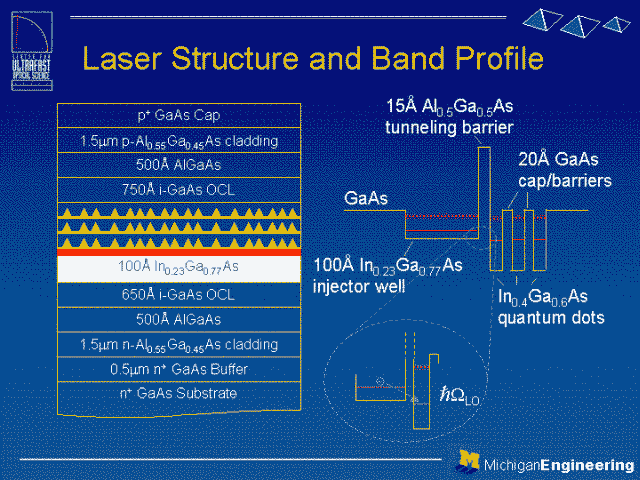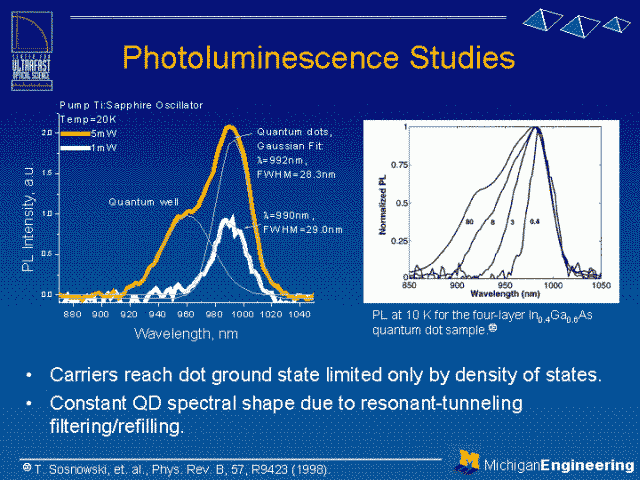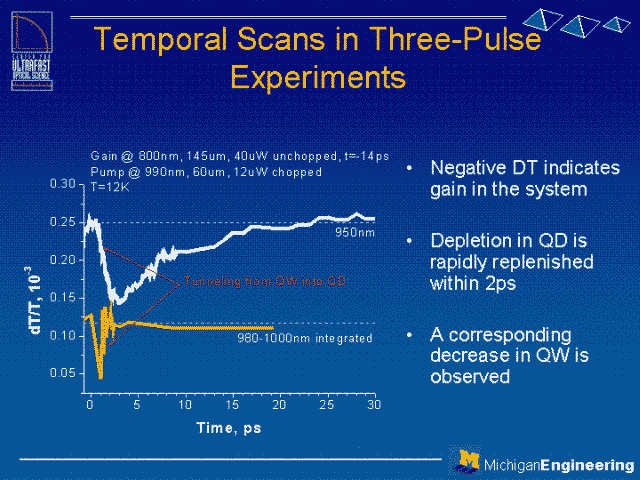Self-assembled quantum dot (QD) lasers have demonstrated significant enhancement in performance in terms of low threshold current, large differential gain, temperature insensitivity, etc. over quantum well (QW) lasers. For high-speed operation, on the other hand, tunneling injection alleviates hot-carrier problems by directly injecting electrons into the lasing state of the QDs. We have previously studied various relaxation processes in QD systems with time-resolve pump-probe differential transmission spectroscopy [1]. Using the same experiment technique, here we present measurements on the QW-QD coupled system.

The active region consists of three layers of In(0.4)Ga(0.6)As QDs, coupled to a 100A In0.23Ga0.77As QW by a Al(0.5)Ga(0.5)As tunneling barrier of 15A. The energy separation between the injector QW and the QD ground state is tuned to one LO phonon energy. Detailed description of the laser structure and experimental setup are presented in [1] and [2].

Photoluminescence (PL) shows, at lower power, the PL is dominated by the QD ground state. As the injection increases, the population in the QD saturates and PL from the QW is observed. The QD linewidth is considerably narrower than observed in standard QD systems at higher injection. The LO-phonon-assisted tunneling process serves as a spectral filter for filling the QDs.

As for differential transmission (DT) experiments, with injection centered at 930nm into the QW, a spectral component at 970nm due to QD ground state can be observed. The time constant of the transition is found to be independent of temperature. This behavior is due to tunneling, in contrast to direct intradot relaxation where the rate depends on temperature reemission into the barrier.

In three-pulse measurements, the system was first inverted with a “gain pulse” introduced at 14ps prior to the pump pulse. With the system filled with carriers (gain>0), the pump pulse removes carriers in the QD ground state by stimulated emission. Note this simulates the lasing action and reveals the carrier dynamics in high-gain regime. The gain in the QD recovers within 2ps and is accompanied by a reduction of population in the QW. The QW is subsequently refilled via carrier cooling.Tunneling injection QD laser with 22-GHz modulation bandwidth and operation up to room temperature have been demonstrated [2]. Detailed and matching modeling for actual device performance was done with all rate constants measured by our group.
References
[1] K. Kim, et. al. Gain dynamics and ultrafast spectral hole burning in In(Ga)As self-organized quantum dots, Appl. Phys. Lett. 81, 4, 670-672 (2002).
[2] S. Ghosh, S. Pradhan, and P. Bhattacharya, Dynamic Characteristics of High-Speed In0.4Ga0.6As/GaAs Self-Organized Quantum Dot Lasers at Room Temperature, Appl. Phys. Lett. 81, 3055-3057 (2002).
